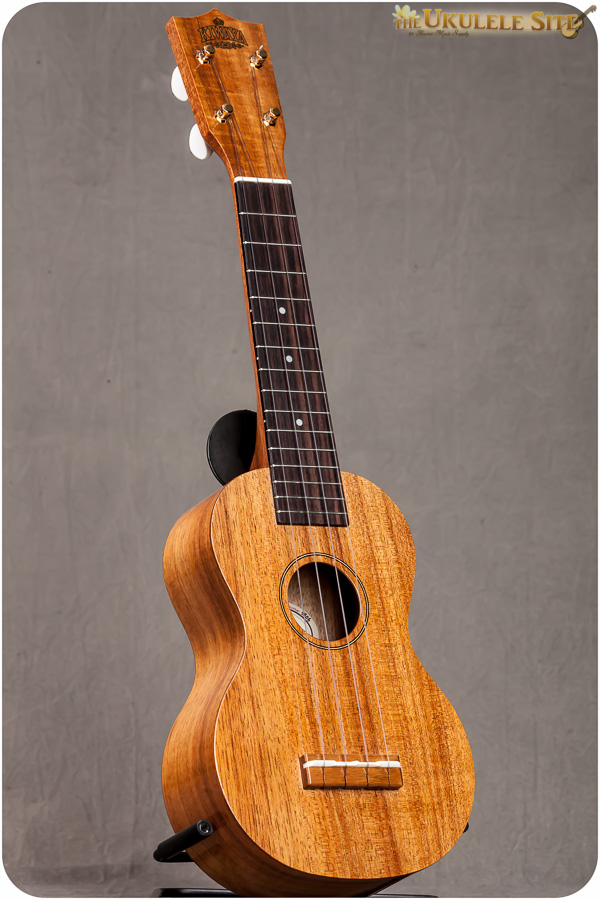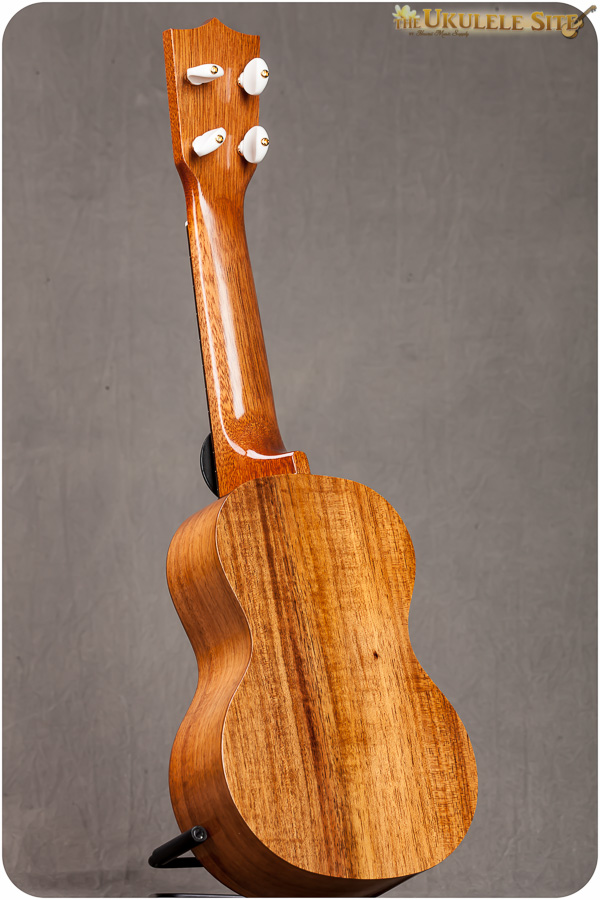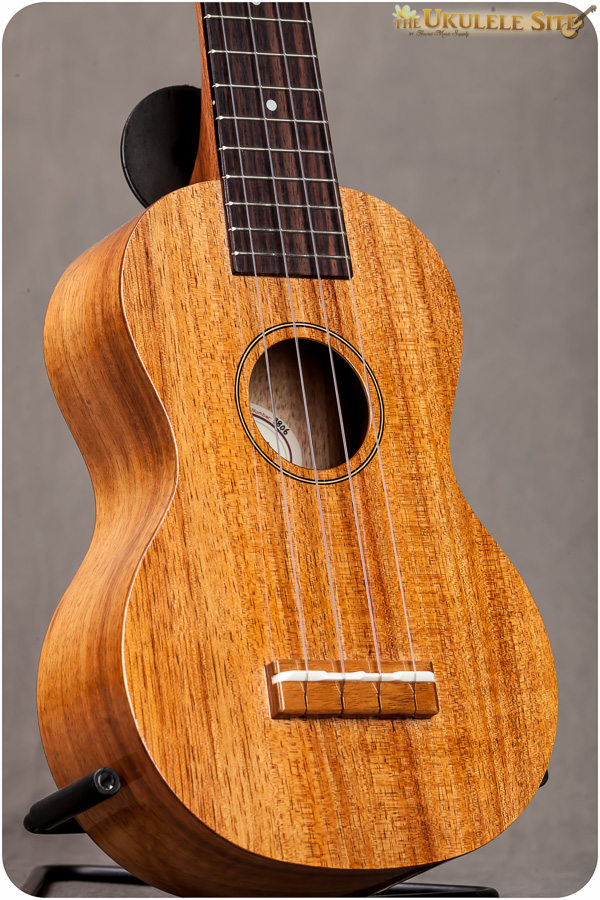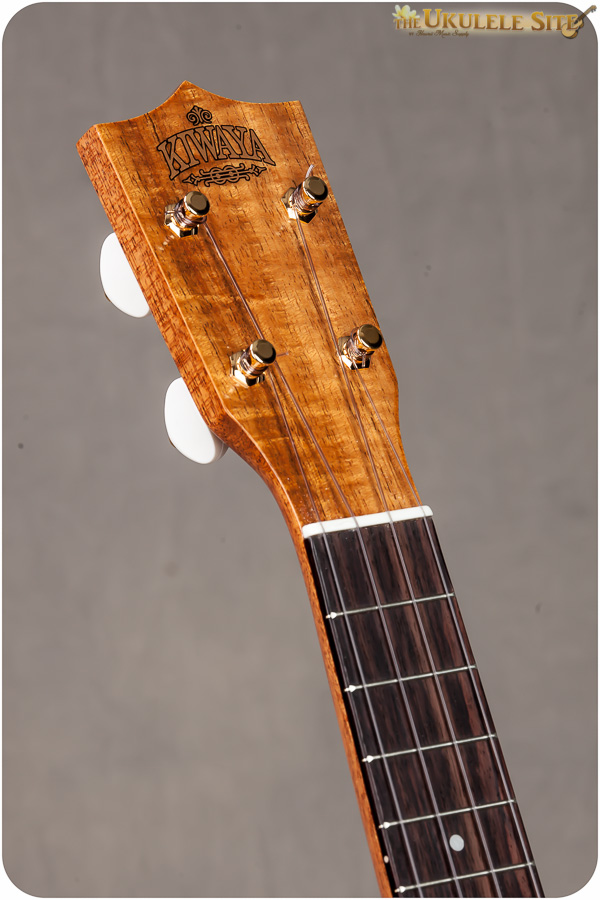He’s right. Where the other sizes of ukulele may be easier to navigate on the fretboard or have deep, rich sounds, it may be easy to look down on the humble soprano, but you shouldn’t. After all, the soprano is what comes to mind most of the time when you talk to people about ukulele. They have a charm all to themselves. They’re small, incredibly portable, light, bright-sounding, and adorable.
This particular ukulele is no exception.
The ukulele I’m reviewing is the Kiwaya KS-5, which has a very vintage look to it with a beautiful koa body and tuners behind the headstock. It isn’t overly adorned and looks just as chill as it sounds.
The koa body features a three-stripe rosette and a bridge that isn’t as involved as you average tie-bridge which results in a cleaner overall look and may make stringing easier if that’s a concern of yours.
The body also has a really nice flame to it looking like an ukulele that is significantly more expensive. The way that they were able to save money was to use a laminate body, which has its pros and cons. While it won’t age and bloom tone-wise like solid-wood instruments, it is more durable for temperature and humidity changes and less likely to crack.
On the headstock, the tuners LOOK like vintage friction tuners, but are actually 4:1 planetary tuners which means they’re lighter, more accurate, more stable for tuning, and they just plain look cooler. This is only compounded when you look at the cool shiny amber-colored plastic buttons.
My favorite part of the ukulele, though, is the fretboard. A soprano ukulele only has so much real estate on the fretboard and putting normal frets on it is a really good way to drastically reduce the amount of fretboard under your fingers. The KS-5, though, has REALLY small frets, both in height and width. Most of the people I’ve met think this is a detriment – a problem – and love huge frets. Huge frets make sense in some spots, but not on a soprano uke as this KS-5 displays. It’s ridiculously easy to play and your fingers are able to slide about with ease. It almost FEELS like a fretless instrument but still SOUNDS correct.
As an added bonus, with small frets, the likelihood of fretting a note too hard and making it sharp are drastically reduced.
So it looks great and plays well, but how does it sound?
Well, it sounds great. It’s bright without being piercing and clear as a bell. The small body makes for a nice mix of sustain and percussiveness and it’s just fun to play and listen to. The volume was a shock as well – it’s plenty loud. It sounds happy. It sounds fun. The sound makes you want to play it more.
It also sounds more expensive than it actually costs. Like I said earlier, Kiwaya decided to go with a laminate koa body, which saves on cost. It’s certainly strange to hear a soprano ukulele that is so loud, sounds so good, and looks so pretty with the cool touches here and there that give all your senses the impressions that you’re playing a significantly more expensive ukulele when it has a laminate body, but here it is.
That’s not to say that it is super cheap, though. The cost comes in at $369.00 which isn’t anywhere near the entry-point of ukulele, but it’s also a far stretch from instruments that look, feel, or sound as good as this one.
Overall, this is a great ukulele in every way that you would probably enjoy. Try it out and see for yourself. There’s just something about strumming a soprano ukulele – especially one as well-crafted as this one.
You can view this ukulele at our website store HERE.





Comments 7
This review was instrumental (hmmm, bad unintended pun) in our purchasing two Kiwaya soprano ukes. We had never heard of them before and can say unreservedly that these are my wife’s two favorite ukes (she has six.)
We appreciate the honest approach you folks offer and believe it does result in increased business. If we ever get to Hawaii, you can be sure we’ll MAKE a visit to the shop. We feel like we know many of them because of the podcasts, lessons, reviews, and help on the phone.
What a beautiful sounding instrument. Laminates get a bad rap in some quarters, but this video clip shows how nice they can sound when they are well-built. And I agree that there are a lot of advantages to small frets on a soprano. I mostly play tenor these days, but I find myself missing the portability, fret reach and relaxed sustain of the soprano.
I have had the pleasure of going to the Kiwaya showroom in Tokyo and would highly recommend it! They make some great ukuleles, including replicas of the vintage Martins.
The next time I go to Tokyo i’ll have to try and find it! It sounds like a really fun stop.
I almost pulled the trigger on this uke, but ended up getting a different one. Now after reading this review I am regretting my decision! I had never really thought about fret size until you mentioned it here, makes a lot of sense that smaller frets would help with intonation – I myself tend to press too hard, so sopranos go out of tune easily when I play them.
I might just have to move this Kiwaya up to the top of my list of next ukes to buy.
Thanks, Russ =)
You’re welcome! I’m glad you enjoyed it.
Good review, thanks! I think the Kiwaya also has a bit wider nut and string spacing like a Martin which makes it great to play. These seem like a really good value.